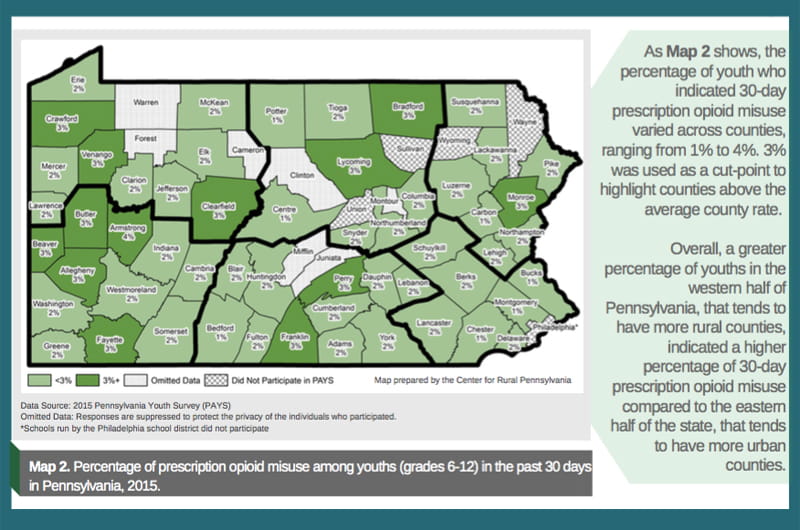State Report: Prescription Opioid Misuse in Young Pennsylvanians Down, But Varies By County
 By Frank Otto
By Frank Otto

- Drexel Environmental Collaboratory Releases Cross-Sector Findings on Severe Weather Recovery Challenges
- Drexel Launches the Manuel Stamatakis Center for Alternative Investments at the LeBow College of Business
- How and When Could AI Be Used in Emergency Medicine?
- Faculty Highlights: Recent Awards and Grants

New data suggests that prescription opioid misuse among young Pennsylvanians has declined in recent years, but levels — and factors surrounding the misuse — vary across the state.
“Understanding the mechanisms that lead to misuse is key — and these data can help inform multiple prevention efforts that can be used to respond to the differences across the state,” said Philip Massey, PhD, assistant professor in Drexel University’s Dornsife School of Public Health.
Massey serves as the chair of the Pennsylvania State Epidemiological Outcomes Workgroup (SEOW), which put out the data study. The group is made up of more than a dozen researchers, including faculty from Drexel and the state Department of Drug and Alcohol Programs (DDAP).
The brief shows that in 2011, 10.8 percent of young adult Pennsylvanians (aged between 18 and 25) were estimated to have misused a prescription opioid such as Oxycontin, Percocet, Vicodin, or others. But by 2014, that number declined to 8.7 percent. Among Pennsylvania youths (12- to 17-year-olds), the estimate went from 6 percent to 4.5 percent in the same span.
However, differences remained across the state, as the western side demonstrated slightly higher levels of misuse. The SEOW divided Pennsylvania up into its six different health districts to better arrange the data. The Northwest District showed the highest rate of lifetime prescription opioid misuse (7.3 percent of youths), with the Southwest District coming in just behind it (7 percent).

At the other end of both the state and the scale, the Southeast District showed the lowest lifetime misuse rate (5 percent), though data for Philadelphia county was unavailable.
Risk Perception High Across State
Statewide, perception of the risks associated with prescription drug misuse — and attitudes against it — were extremely high.
When it came to how people themselves thought of prescription drug misuse in 2015 (the most recent year available), at least 80 percent of respondents in every health district thought it was risky. Every district also featured at least 83 percent of respondents feeling their peers disapprove of prescription drug misuse, and at least 84 percent of respondents in every district disapproved of their peers misusing them.
“While perceptions of risk are relatively high, there are areas of opportunity across the state to underscore the risk associated with misuse, while also building upon already healthy perceptions and peer norms,” Massey said.
This could be important given that it seems perceived risk rates might have fallen slightly.
In 2013, statewide, the rate of youths who perceived prescription drug misuse as risky stood at 85.9 percent. In 2015, that rate was 82.4 percent. Perceived parental disapproval and disapproval toward peers misusing prescription drugs also fell slightly, each by about 2 percentage points.
This decline may not be as concerning as it appears, though.
“When only comparing two time points, it is hard to say whether there is trend,” Massey explained. “We can say, however, that there was a significant difference in perceived risk between 2013 and 2015, but it is difficult to attribute this change to any one thing such as rates of misuse or changing social norms.”
Ease of Access
“Perceived ease of access to prescription drugs varied across counties, ranging from 17 to 37 percent of youth who reported that it was easy to acquire prescription drugs,” Massey said.

The perception that it was easy to get drugs climbed from 24.3 percent to 27.8 percent between 2013 and 2015. The counties with the highest rates of perception that the drugs were easy to get skewed to the west.
Ways that young people got prescription drugs trended about the same across the state, with notably more youths saying they were given prescription drugs as opposed to taking them from someone without their permission. The two places where that was different were the Southeast and Northeast Districts, where the differences between being given and stealing drugs was negligible.
Improving Efforts
Massey and the SEOW team hope their data can be used to provide better services and strategies for combatting opioid spread in Pennsylvania.
“It’s a large and diverse state — both in terms of geography and demographics — and, because of this, has a diversity of needs and assets when it comes to prescription opioid misuse,” Massey explained.
The county-by-county differences in how youths obtain opioids are an example of that, he said.
“Prevention efforts will likely be most effective if they are tailored to address diversity like that,” Massey said. “A one-size-fits-all approach is less likely to be effective.”
Next steps toward better understanding the different ways young people encounter and think about opioids in Pennsylvania would involve studying factors like family, community or environmental factors.
“We will need to continue to move beyond traditional descriptive data to get at these drivers of misuse,” Massey said.
In This Article
Contact
Drexel News is produced by
University Marketing and Communications.